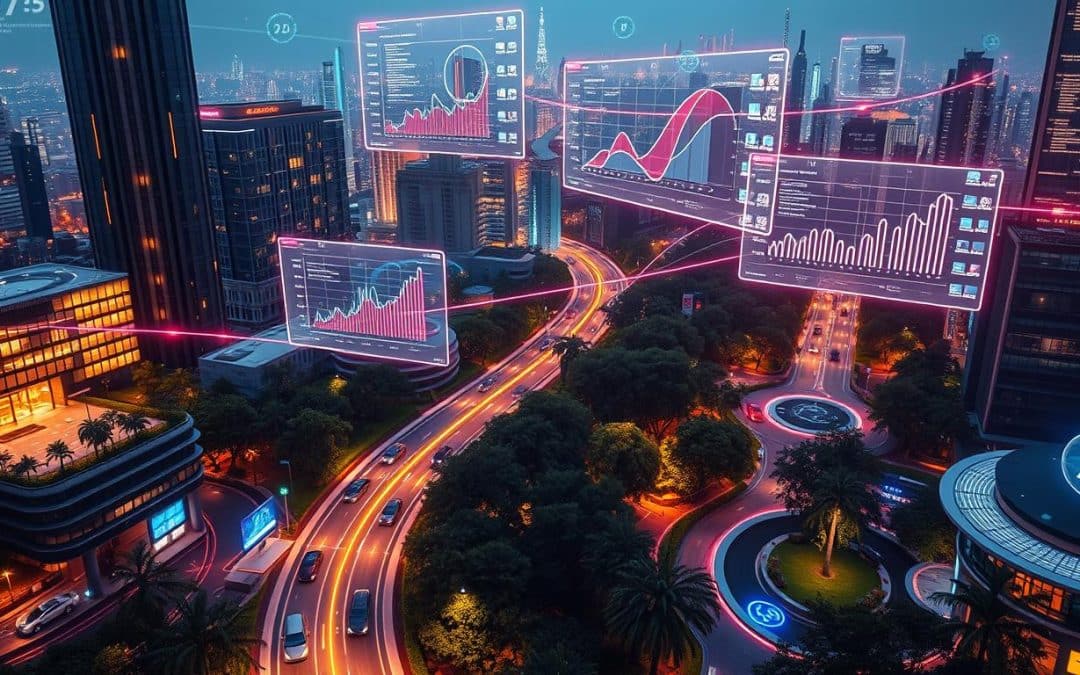The Internet of Things (IoT) is revolutionizing how businesses operate and make decisions. IoT analytics transforms the vast amounts of data generated by connected devices into actionable insights, driving efficiency and innovation across industries. This article explores the key aspects of IoT analytics and its impact on modern business practices.
Key Takeaways
- IoT analytics is crucial for transforming data from smart devices into actionable insights.
- Real-time monitoring and data visualization are essential components of effective IoT analytics.
- AI and machine learning are enhancing the capabilities of IoT analytics systems.
- Challenges in data privacy and integration must be addressed for successful implementation.
- Future trends point towards more advanced, AI-driven analytics and edge computing solutions.
Understanding IoT and Smart Devices
The Internet of Things refers to the network of interconnected devices that communicate and share data. Smart devices range from consumer electronics to industrial machinery, all enhanced by IoT technology. These devices generate massive amounts of data, creating both opportunities and challenges in data analysis.
Key facts about IoT and smart devices:
- The IoT market in building industries is expected to grow from $11.2 billion in 2022 to $44.2 billion by 2031.
- Unique device identifiers are crucial for secure IoT connections, especially as cloud and AI technologies advance.
- The market for blockchain in IoT was valued at $0.57 billion in 2022 and is predicted to grow rapidly.
Key Components of IoT Analytics
IoT analytics comprises several essential components that work together to turn raw data into valuable insights:
- Data Collection: Gathering information from various IoT devices and sensors.
- Data Processing: Using advanced algorithms and analytics tools to identify patterns and trends.
- Machine Learning: Employing AI to enhance data analysis and predictive capabilities.
- Edge Computing: Processing data closer to its source for faster analysis and reduced latency.
- Data Visualization: Creating easy-to-understand visual representations of complex data sets.
How IoT Analytics Transforms Data into Insights
IoT analytics uses statistical analysis and machine learning to uncover patterns in device data, revealing valuable insights that raw data alone cannot provide. This process enables:
- Predictive maintenance to reduce equipment downtime
- Optimization of resource utilization
- Enhanced customer experience through personalized interactions
- Improved decision-making based on real-time data
By 2026, it’s predicted that 20% of organizations will use AI to streamline their structures, potentially reducing middle management positions.
Real-Time IoT Monitoring for Improved Performance
Real-time monitoring is crucial for IoT analytics, allowing organizations to quickly adapt to changes. With the advent of 6G technologies, businesses can achieve data speeds up to 1 Tbps and enjoy very low latency, enabling immediate data processing and smart decision-making.
Benefits of real-time IoT monitoring include:
- Reduced downtime through immediate troubleshooting
- Enhanced safety measures via continuous monitoring
- Optimization of system performance through proactive adjustments
IoT Data Visualization: Making Complex Data Accessible
Data visualization tools are essential for making IoT analytics accessible to non-technical users. These tools include interactive dashboards and user-friendly interfaces that help translate complex datasets into easily understandable visual formats.
Effective data visualization techniques include:
- Interactive dashboards for real-time data monitoring
- Heat maps to represent data density and intensity
- Charts and graphs to show trends and relationships in data
Challenges in IoT Data Analysis
Despite its benefits, IoT data analysis faces several challenges:
- Data Privacy: Protecting sensitive information from unauthorized access and breaches
- Integration Complexities: Harmonizing data from diverse IoT devices and frameworks
- Data Quality: Ensuring consistency and accuracy in large datasets
Addressing these challenges requires robust security measures, standardized protocols, and advanced data management techniques.
Future Trends in IoT Analytics
The future of IoT analytics is shaped by emerging technologies and evolving business needs:
- AI Integration: Enhanced decision-making through machine learning algorithms
- Edge Computing: Faster data processing at the source of generation
- Advanced Data Techniques: Sophisticated methods like predictive analytics for deeper insights
- Collaborative Data Ecosystems: Sharing and combining datasets across organizations for comprehensive market understanding
Conclusion
IoT analytics is transforming how businesses operate, offering unprecedented insights from connected devices. As technologies like 6G and AI continue to evolve, the potential for IoT analytics to drive innovation and efficiency will only grow. Organizations that embrace these advancements and address the associated challenges will be well-positioned for success in an increasingly connected world.
FAQ
What is IoT analytics?
IoT analytics examines the data from devices in the Internet of Things. This helps gain important insights to better performance and efficiency.
Why is IoT analytics important?
It’s key because it handles a lot of data fast. Thus, companies can make smart choices, improve customer service, predict needs for maintenance, and use resources well. This leads to success in business.
What are some examples of smart devices used in IoT?
There are many smart devices like thermostats, wearable health gadgets, industrial tools, and home systems. These gadgets share data, offering a deep look into device analytics and insights.
What are the key components of IoT analytics?
IoT analytics bases on gathering data, processing it, and showing it in an understandable way. Using platforms and tools, it digs deep into data for insights.
How does IoT analytics convert raw data into insights?
It uses stats, learning machines, and ways to show data crystal clear. This helps businesses spot trends and make plans that work.

